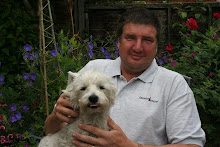 |
Burning the old broken end of your muck fork out of the
metal socket by sticking it in the range over night. |
Our cold winds and haily, showery weather look ready to make this the coldest, most miserable May anyone can remember. I don't think the temperatures have topped 12 or 13ºC all month and the bee keepers at our meeting last night in Longford were saying that their hives are not getting any 'flow'. This is the word they use to descibe the huge in-pouring of nectar which foraging bees can bring to a hive when the suitable flowers are out - you get a "dandelion honey-flow" or a "horse chestnut flow".
 |
| New toys! Sheep shears. |
This year, though, everyone is waiting for the hawthorn (they call it 'whitethorn' here) flow to start and they are wryly commenting that it is 19th May and not a whitethorn flower open yet! So little nectar and pollen is coming into the hives that the nutrition in it is going straight into the brood comb for the young larvae. There is little left over for the bees to stash away in the honey-comb for stores. On the plus side, the colonies will be slower to swarm, if they have that in the back of their minds.
 |
| New toys - sheep shears and a butcher's bone-cutting saw. |
There is also better weather forecast. I'll be happy if the chilly wind just eases off - I'm not too worried about the showers. I am well set up with my raised beds as regards drainage and not having to walk on the seedbeds, so as long as it has not actually been torrential overnight I can work. I get down there with my knee pads and hunker down in the 'trenches' between the raised beds, protected a bit by the hawthorn hedge and the tall stuff like purple sprouting broccoli, artichokes and raspberries and I'm warm enough. Only when I stand up to lug a full weed bucket to the compost do I get reminded of how bloomin' cold it is.
 |
| The rather alarming business end of those shears. |
They say you are never too old to learn something new, and yesterday, down in the 'allotment' I took on one more grain of gardening know-how; one of those which is obvious when you think about it but had not occurred. Back in April, with frost forecast, we raced to throw some protection over the newly emerging 'baby' asparagus crowns. I used some hay, being the first thing that came to hand. When the frost was done, I left it there thinking it would do no harm. Yesterday I went to see why the thriving shoots, which I had been so anxious to protect, were not now doing anything and noticed one keeled over with obvious slug/snail tongue-rasp marks. Pulling up the old damp hay, I found, to my horror, Slug-Central - dozens of the little critters hiding under all that nice warm damp hay and presumably feasting on my precious asparagus overnight. Moral: if you use hay to protect plants from frost, take it up again when it warms up.
 |
| Mary's face showing her intriguing white eyelashes |
New toys for 2015; we have invested in a set of sheep shears and a butcher's bone-cutting saw. I plan to learn to shear this year so that I am not beholden to a neighbouring farmer or sheepy colleague remembering to invite my 2 or 3 girls over to be included in their mass-shearing. People here use traveling contractors who drive from farm to farm with portable pens, shearing 'stages' and shears. They expect to be doing dozens or hundreds of sheep and the economics don't work if you only have three, so small holders like me would normally try to sneak in on shearing day with our few.
 |
| Isabelle (nearest camera) and Mary. |
This works as long as your host-farm remembers you and as long as you get warning to keep your sheep indoors to make sure they are dry - you cannot shear wet sheep. In the case of Mayo-Liz, we have also been promised that if we turn up on shearing day, the "bloke doesn't mind" showing anyone how it's done and giving them a small master-class training session with plenty sheep to practise on. I am wondering whether to go with that this time for training purposes, or whether to shear mine if I get a dry three days and go for the practise anyway.
The bone saw was a bit of a luxury and quite pricey but anyone who has tried to use a standard carpenter's hack-saw on bone will know that it is very necessary if you want to butcher up your half-carcass in a reasonable time. Hack saw blades quickly clog with bone shards and bits of membrane and sinew. A bone saw blade has teeth of a special size and shape designed to shed this debris and allow the blade to keep working.
 |
| A first chick hatches under the broody Buff in the Tígín |
We are still very much enjoying the pigs. They are complete charmers. I am intrigued by Mary's face, which has the big white stripe up her snout but also a bright 'spray' of white eyelashes on her right eye. The other side, and all Isabelle's eyelashes are black. Pigs also have a bristly row of hairs above the lashes as a thin 'eyebrow'. I also love their curly tails which are always in motion being unwound and wound up again as they move about and which they wag like a dog to show pleasure. Our Tamworths last year had had their tails either bitten off or docked when they were tiny, so that we only got a few inches of curl, but Mary and Isabelle's are intact.
 |
| Thereby hangs a tail. |
Finally, 'breaking news' just today, as the first baby chick hatches under the broody Buff Orpington in the Tígín. This is something of a relief, as the girl had cruised past due date (Saturday) and then Sunday and Monday too, looking a bit more agitated but never letting those little cheep-cheep noises out from under her skirts. Today she hopped off the nest to go do her toilet just as I went out for a check, and I spotted the new chick. Unfortunately, there is also one in there who didn't make it - you can see the rather mashed looking egg directly behind the new chick in the pic. This was a fully formed, almost hatched, but dead and stiff chick who never quite escaped the egg for whatever reason. Mum is back on the nest now with the baby but without the dead one, so maybe she will tempt some more out overnight.










2 comments:
Now would be a good time to swipe the rest of the eggs out and into the incubator, Buffs are very clumsy when it comes to their eggs but great at brooding.
Did you mean hay when you said about covering your asparagus? You should not use hay as a mulch, it carries far too many weed seeds, straw on the other hand does not.
Thanks for the incubator thing.
This was hay, loosely speaking; actually the dried up strimmings from long stuff around the orchard from when I last went round bashing plantains so, yes, it may contain seed, but only of 'grass' that is 10 yards away anyway.
Post a Comment